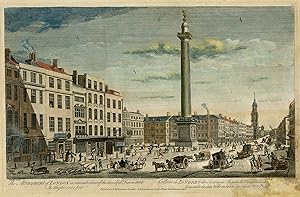Bowles Thomas Iii (1 results)
Product Type
- All Product Types
- Books (1)
- Magazines & Periodicals
- Comics
- Sheet Music
- Art, Prints & Posters
- Photographs
- Maps
-
Manuscripts &
Paper Collectibles
Condition
- All Conditions
- New
- Used
Binding
- All Bindings
- Hardcover
- Softcover
Collectible Attributes
- First Edition
- Signed
- Dust Jacket
- Seller-Supplied Images
- Not Printed On Demand
Seller Location
Seller Rating
-
The Monument of London in Remembrance of the Dreadful Fire of 1666
Published by John Bowles & Richard Wilkinson, 1751
Seller: Rob Zanger Rare Books LLC, Middletown, NY, U.S.A.
Steel engraving with extensive hand coloring in watercolor on cream wove paper, 10 1/4 x 16 inches (260 x 406 mm), 1/4-inch margins. Significant insect damage only in the lower right corner, resulting in the loss of the corner, which has been expertly repaired with archival materials. There is also some worming along the lower right margin. Colors remain fresh and vibrant. The Monument to the Great Fire of London, most commonly known simply as "The Monument," is a fluted Doric column in London, situated near the northern end of London Bridge. Commemorating the Great Fire of London, it stands at the junction of Monument Street and Fish Street Hill, 202 feet west of the spot in Pudding Lane where the Great Fire started on September 2nd of 1666. Designed by Christopher Wren and Robert Hooke, it was constructed between 1671 and 1677, and was built on the site of St Margaret, New Fish Street, the first church to be destroyed by the Great Fire. Wren and Hooke designed the monument to double as a scientific instrument. It has a central shaft meant for use as a zenith telescope, and for use in gravity and pendulum experiments. The shaft connects to an underground laboratory for observers to work (accessible through a hatch in the floor of the present-day ticket booth). Unfortunately, vibrations from heavy traffic on Fish Street Hill rendered the experimental conditions unsuitable, and for the most part, that component of The Monument's construction has been abandoned. However, the building was utilized for scientific purposes as recently as 2020, when researchers from Queen Mary University of London published findings made while using the shaft of the monument stairwell to measure deformation in a hanging wire.


